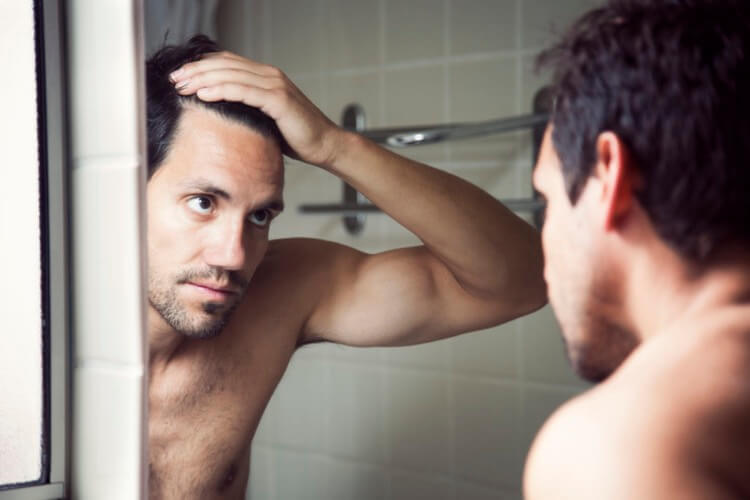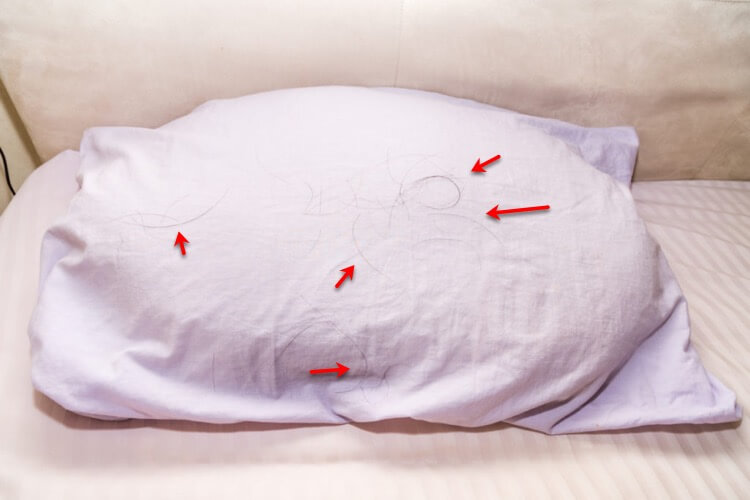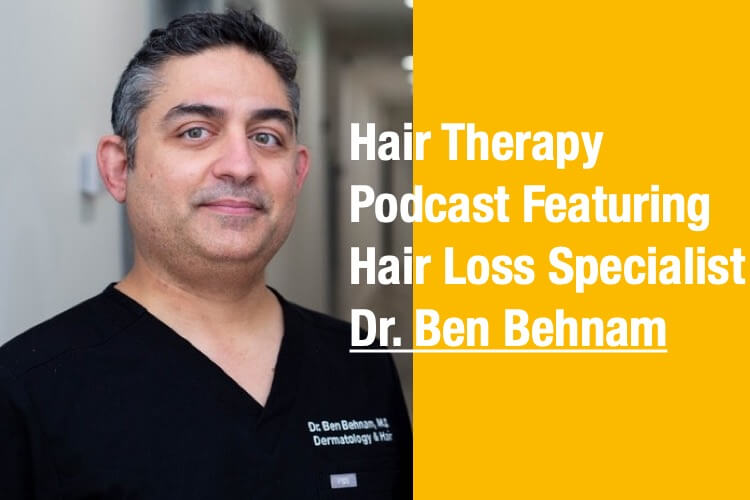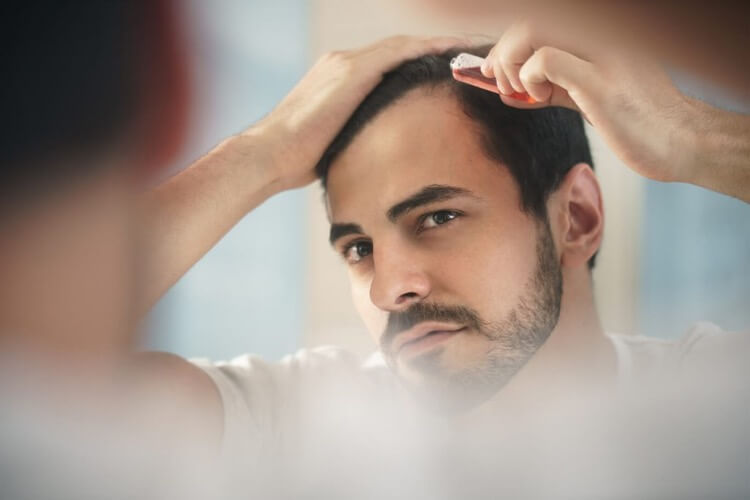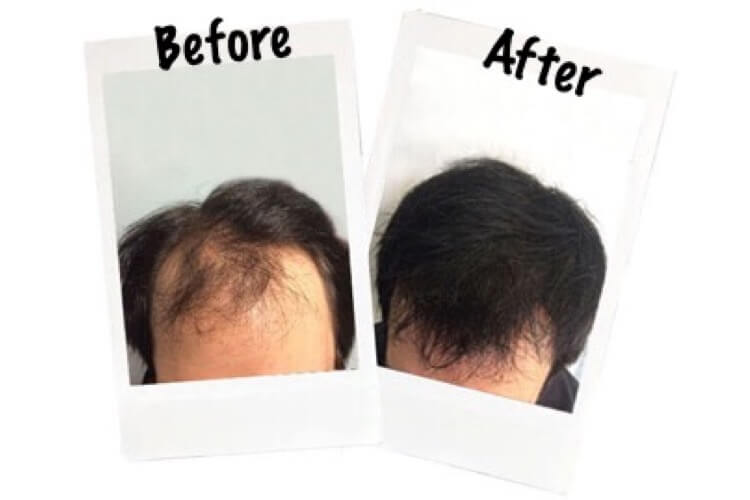Hair Loss Reversal 101: What You Need to Know
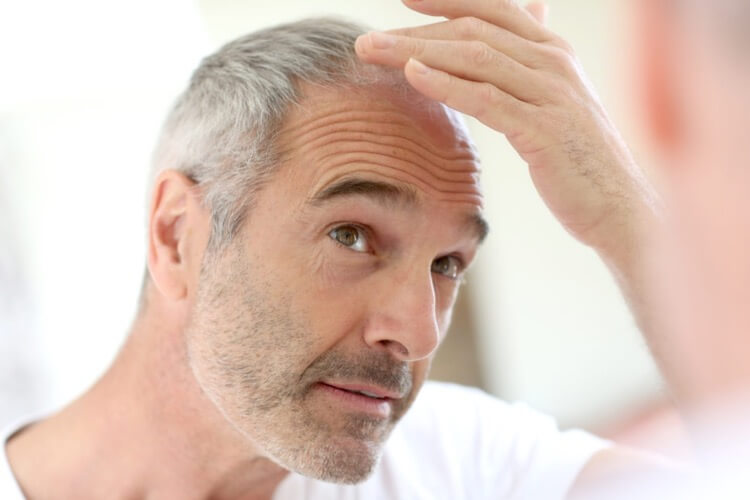
If you’re experiencing hair loss, you’re not alone. According to the American Hair Loss Association, at least two-thirds of all American men will have noticeable hair loss by the time they turn thirty-five. Women account for forty percent of all Americans experiencing hair loss. (01) Those numbers are much higher than you thought, right?
Sure, most people expect to get some gray hair, wrinkles, and a few extra pounds as they age, but hair loss? That’s not usually part of the plan. We can color our hair, use Botox for our wrinkles, and spend some extra time at the gym. But what can be done about a receding hairline? More than you think.
There are Different Types of Hair Loss
The first step is to understand the different types of hair loss. All hair loss is not the same, so not all hair loss will respond to the same treatment. We’re here to give you a crash course.
The Term Alopecia Encompasses More Conditions Than Most People Realize
When people think of alopecia, they usually think of alopecia areata, the type that Massachusetts Representative Ayanna Pressley and actress Jada Pinkett Smith have. However, if you use Dr. Google, you’ll see that WebMD defines alopecia areata as an “autoimmune disorder that causes your hair to come out, often in clumps the size and shape of a quarter.” The definition is accurate, but not all hair loss is alopecia areata. Alopecia is an umbrella term for many different hair loss conditions.
There’s a Difference Between Non-Scarring and Scarring Alopecia
Alopecia falls under two broad categories: non-scarring and scarring alopecia. There’s a big difference between the two types.
When people have non-scarring hair loss, their hair just falls out. No redness, scaling, flaking, itching, or burning occurs. The alopecia can come on fast and furiously, leaving people holding clumps of hair in their hands, or gradually over a long period of time.
Scarring alopecia is a different story. Also known as cicatricial alopecia, scarring alopecia is an inflammatory condition that occurs in otherwise healthy people. The hair follicle is destroyed and replaced with scar tissue. The hair loss can happen over time and go unnoticed, or it can happen quickly, causing symptoms such as severe itching and burning. (02) Speed is essential when it comes to treating scarring alopecias. The goal is to slow or stop further hair loss and promote hair regrowth in unaffected areas.
What Type of Alopecia Do You Have?
Many different types of hair loss fall under the categories of non-scarring and scarring alopecia. Once you know what type you have, your dermatologist will work with you to develop a treatment plan.
Examples of Non-scarring Alopecia
Telogen Effluvium
Telogen Effluvium is a form of temporary hair loss caused by stress, severe chronic illness, high fever, childbirth, thyroid disorders, major surgery, dieting, certain medications, etc. Telogen Effluvium usually resolves itself over time.
Androgenic Alopecia
Also known as male and female pattern baldness, androgenic alopecia is a genetic condition experienced by up to 50 percent of men and women. (03) Experts believe that pattern baldness is due to an excessive androgen dihydrotestosterone (DHT) response which causes hair follicles to miniaturize. When the hair follicles shrink, hair loss occurs. Androgenic alopecia typically causes frontal hair loss in men and diffuse hair loss at the crown and top of women’s heads.
Alopecia Areata
If your hair falls out in clumps around the size and shape of a quarter, you may have alopecia areata. This condition is an autoimmune disorder that occurs when your body attacks its own hair follicles. With alopecia areata, hair loss is unpredictable and can happen anywhere on your body. Sometimes the condition resolves itself. However, it can also reoccur without notice. Many research studies are currently underway to understand the cause and effective treatment. (04)
Traction Alopecia
Constant pulling on hair due to tight ponytails, buns, braids, cornrows or dreadlocks, hair extensions, weaves, and more can cause traction alopecia. This condition, that’s common among actresses and models, can cause small bumps that resemble pimples. Fortunately, traction alopecia can be reversed if you stop pulling your hair back.
Examples of Scarring Alopecia
Lichen Planopilaris
Lichen Planopilaris is the most common type of scarring alopecia. Although it can affect both genders, lichen planopilaris is more likely to affect women aged 40 to 60 than men. (05) Redness, itching, burning, and tenderness can accompany frontal or other pattern hair loss.
Central Centrifugal Cicatrical Alopecia (CCCA)
CCCA is found almost exclusively among black women aged 30 to 55 year-old. The cause is still unknown and is being researched. Women who experience CCCA experience inflammation and associated hair loss in the crown area. (06)
Effective Hair Loss Treatment Complements Your Diagnosis
After your dermatologist determines the cause of your hair loss, he or she will discuss treatment options with you. Keep in mind that hair reversal treatments are not one-size-fits-all. In some cases, “cocktails” which combine specific medications and protocols may be needed. Just to give you an idea of what’s out there, here are some of the most frequently used medications and treatments:
Minoxidil (Rogaine)
Minoxidil, also known as Rogaine, is available over-the-counter as a topical foam and liquid and by prescription as an oral pill. Minoxidil is a vasodilator reduces miniaturization of the hair follicles and elongates the growth phase.
Minoxidil has proven to promote growth among men and women with male and female pattern hair loss. Minoxidil is also often recommended to patients with scarring alopecia to promote growth in unaffected areas.
Once you start using Minoxidil, you need to continue. When you stop using the medication, any new hair that grows will most likely be shed.
Finasteride (Propecia, Proscar)
Finasteride is a 5 alpha-reductase inhibitor originally designed to treat enlarged prostates. The medication, available both as a pill and a topical solution, blocks the conversion of Testosterone to dihydrotestosterone (DHT), a hormone that inhibits hair growth.
Clinical studies have found Finasteride to be highly effective in reversing hair loss in both men and women with scarring and non-scarring alopecias. (07, 08) Topical Finasteride is often used to treat androgenic alopecia, while oral is typically recommended for scarring alopecias.
Finasteride is only available by prescription and is not recommended for women of childbearing age. Check with a board-certified dermatologist to see if you are a good candidate for the topical or oral treatment. Don’t have time to make an appointment? Don’t worry, you can get custom topical treatments and oral medications prescribed by a Happy Head board-certified dermatologist, have a consultation and get it all shipped to your door each month. Just fill out our quick questionnaire, send us a few photos, and get started on growth here.
Corticosteroids
Topical or injected steroids are often used to treat hair loss that is induced by autoimmune diseases such as alopecia areata and lichen planopilaris. The corticosteroids allow hair to grow by inhibiting the autoimmune disease.
Steroid treatments are only available by prescription and should be surprised by a qualified dermatologist.
Platelet-rich Plasma (PRP) Injections
PRP injections have become a popular treatment for healing wounds and regrowing tissue such as tendons, ligaments, and muscles.
PRP has regenerative properties and has been primarily tested on patients with androgenetic alopecia. (09) When injected into the scalp, PRP is believed to stimulate hair growth by increasing blood flow to the hair follicles and increasing the size of the hair shaft.
As the name suggests, PRP injections are made from platelets derived from your blood. Blood is first drawn, and then spun at super high speeds to separate the blood components. The resulting plasma is highly concentrated.
PRP use is still in its early stages and can be expensive. Research also indicates that PRP is most effective when used with Minoxidil, Finasteride, and other hair growth treatments.
Biotin
Biotin, also known as Vitamin B7 or Vitamin H, has become a familiar hair growth supplement. Sold in supplements or as an ingredient in hair care products, Biotin is promoted as a way to make your hair grow longer and healthier.
Does it work? Well, the jury is out. Not enough research has been conducted to say yeah or nay. (10) It won’t hurt you to try a new shampoo that contains Biotin, but there’s no evidence to indicate that it will help. Biotin deficiency is rare. (11) Most people get adequate amounts through their regular diets.
Many Biotin supplements sold are not FDA approved, and high concentrations of Biotin can interfere with the results of some lab tests. (12) As with any oral supplement, check with your doctor before testing it out.
Hair Transplants
Hair transplant procedures and techniques continue to improve over time. Rather than using noticeable plugs, today’s surgeries move hair strips or carefully selected hairs from one area to another to promote growth that looks natural.
When determining whether a patient is an ideal candidate for a hair transplant, dermatologists consider several factors, including:
- Type of hair loss
- Degree and pattern of baldness
- Patient age
- Hair color
- Donor hair density
- Patient expectations
Although hair transplants are expensive and time-consuming, they are an effective, reliable, and safe way to get lasting results.
It’s Important to Set Realistic Expectations When Treating Alopecia
We’re fortunate to live during a time when hair loss research is prolific, and the list of hair replacement options is growing. Whether you’re 25 or 55, you don’t have to live with bald spots, a receding hairline, or thinning hair, even if your genetics or immune system are working against you.
The first step is to find a board-certified dermatologist and hair specialist you trust and get diagnosed. He or she will help you select the right treatment option for your type of alopecia and lifestyle. Remember to set realistic expectations for your hair regrowth. Treatments don’t work overnight, so be patient and track your progress over time. After all, small signs of stubble today can lead to a fuller head of hair tomorrow. To get in touch with a Happy Head dermatologist and do your consultation over the phone, get started here and you can do it all from home.
Resources:
(01) https://www.americanhairloss.org/
(02) https://rarediseases.org/rare-diseases/cicatricial-alopecia
(03) https://www.ncbi.nlm.nih.gov/books/NBK430924/
(04) https://www.aad.org/public/diseases/hair-loss/types/alopecia
(05) https://www.ncbi.nlm.nih.gov/books/NBK470325/
(06) https://jamanetwork.com/journals/jamadermatology/fullarticle/2768748
(07) https://www.ncbi.nlm.nih.gov/pmc/articles/PMC4809380/
(08) https://pubmed.ncbi.nlm.nih.gov/9951956/
(09) https://www.health.harvard.edu/blog/platelet-rich-plasma-does-the-cure-for-hair-loss-lie-within-our-blood-2020051119748
(10) https://www.ncbi.nlm.nih.gov/pmc/articles/PMC5582478/
(11) https://www.ncbi.nlm.nih.gov/pmc/articles/PMC5582478/
(12) https://www.fda.gov/medical-devices/in-vitro-diagnostics/biotin-interference-troponin-lab-tests-assays-subject-biotin-interference

